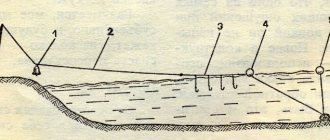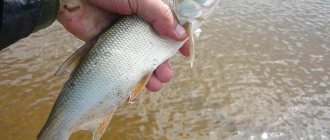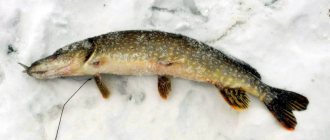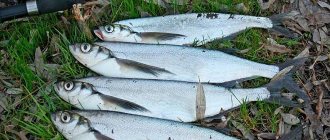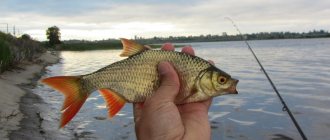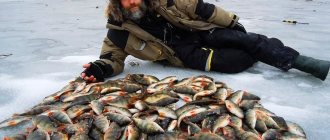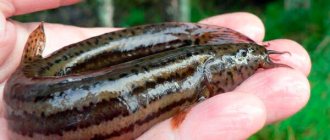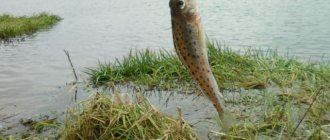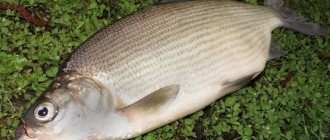Features of winter fishing for saberfish
Fishing for sabrefish in winter is not among the traditional and widespread fishing activities, like, for example, perch fishing. And the best chance of catching this fish during the winter period is on the first and last ice. Even in the fall, flocks of sabrefish move from relatively shallow places and riffles at the boundaries of holes to deeper places with a reverse current. Unlike in summer, when saber fish most often stay on edges with strong and moderate currents, in winter flocks of sabrefish stick to places with weak currents. This is probably to some extent due to the economy of energy during the winter season, when saber fish spends its vital resources to withstand the cold. In addition, in winter, this fish feeds less and less frequently. Therefore, the life cycles of saberfish slow down. Regarding the choice of fishing location, it should also be noted that sabrefish dislike grassy areas. This dislike of her also extends to winter. At the beginning of winter, sabrefish can also be found in old places where until recently they were caught in the fall on a donka with a rubber shock absorber. Towards the middle of winter, this fish goes to the pits. And its feeding exits occur on the borders of these pits at a depth of three to five meters. It is best to catch saberfish during long thaws . And the longer the thaw and the closer spring is, the more often it will be possible to catch saberfish in the surface layers of the water. Chekhon does not tend to the bottom even in summer and often stays in the middle and upper levels of the river. Only in the dead of winter does it stay near the bottom. With warming and fresh water entering under the ice, flocks of saberfish rise upward. Especially large concentrations of this fish occur at the mouths of rivers and streams flowing into a large river, for example, the Volga.
Biting and fishing
Finally, the long-awaited bite occurred. Hook, but make sure the line always remains taut.
Tip: the fishing line should swing to the side, but strictly in the direction of the wind.
Pull the fish out carefully, trying not to catch the line on the edge of the hole. Don't rush, don't make noise, don't fuss, otherwise you will alert or scare away a school of fish. When fishing with a garland, it is important to constantly improve, and then a positive result will not be long in coming.
Read! How to choose a good ice screw for fishing
Chekhon in winter for edible rubber
The spread of edible rubber baits has also affected winter fishing, including sabrefish. And often the Hoagy Hog bait made of edible rubber outperforms traditional baits - bloodworms and maggots. Despite the fact that this bait is not similar to any underwater insect or animal, this strange artificial crustacean with legs, claws and tails made of rubber often causes excitement in the saber fish and a desire to grab the jig from the Hoagie Hog. At the same time, the fishing technique itself is not much different from fishing with a jig and bloodworm. A small light-colored jig is used, on which a Hogi Hog is placed, starting from the “head” to the “belly”. But you need to select a jig with a hook, the size of which should be disproportionately large compared to the body of the jig. Otherwise, it will be difficult to catch a large bait by placing it on a small hook. The jig's action is most often used smoothly and leisurely, as when fishing for bream or roach. The legs, tentacles and tail will act out movements even with weak vibrations of the jig, which will be an attractive prey behavior for the gambling saberfish. After all, the saberfish, despite its silvery scales, is a real predator, especially the large saberfish.
Tackle and equipment

As a rule, the weight of the fish caught when fishing with a garland in winter is small (no more than 1 kg), so the model and design of the fishing rod does not play a special role. If the goal of your fishing is a more serious fish, then you should take a more reliable fishing rod.
Read! On eriki for large roach
The length of the nod can reach up to 20 cm. It should be moderately rigid and have an inclination angle within fifteen degrees. Most fishermen choose flat, adjustable steel nods.
The line should not be very thick. Yes, it is stronger, but the action of the bait will not be as expressive, the fish will be scared of it, so 0.15 mm is quite suitable.
The preferred models of jigs are: “Devil”, “Uralka”, and “Ant”.
It is recommended to tie jigs without knots, for which the required piece of fishing line is unwinded, threaded into the loop of the bait, and drawn through the entire length. All that remains is to wrap the tip around the thread over the bait several times, pass it into the eye of the hook, and at the same time stretch the place of the winding.
Winter fishing rod based on the “float” principle
The simplest and often the most effective gear is a winter fishing rod, designed on the principle of summer float gear. Along with saberfish, bleak often bites well on it. The tackle is designed almost like a classic winter fishing rod, that is, a winter fishing rod with a stand for installation at the hole has a reel and a nod, but instead of a jig, the smallest hook is attached, and a sinker is attached above. Bloodworms and maggots, as well as Hoagie Hog, are attached to the hook. As spring approaches, there are more and more bites for maggots.
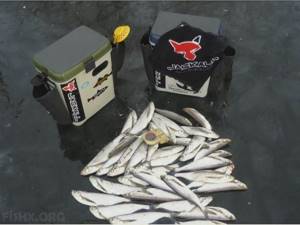
Equipment Features
We select the feeder depending on the conditions of the reservoir - casting distance, current, required weight of the feeder. You can work with either a picker or a heavy river feeder. When fishing for saberfish, equipment and selection of horizon are more important. Fishing is active and requires constant recasting, so it is more convenient to work with light, comfortable gear.
Equipment for catching sabrefish on a feeder can be in any type of installation - paternoster, loop (symmetrical or asymmetrical), inline, helicopter, anti-twist. It is only important to deliver the hook with the nozzle to the desired height. Therefore, an obligatory part of the work is selecting the height of the bait in the thickness. It is easier to work with helicopter feeder equipment, with stoppers instead of knots. The leash on this type of feeder installation sinks more slowly, moreover, the point of its attachment to the base can be raised higher by selecting the desired horizon. Similarly, you can use a paternoster with a long branch to the feeder, up to 70 cm. However, it should be taken into account that the higher we raise the attachment point of the leash, the greater the likelihood of overlap when casting.

Scheme of operation of the running equipment, symmetrical and asymmetrical loops.
If the current is weak, we mount the feeder equipment for sabrefish on the basis of the lightest feeders so that everything sinks more slowly, giving away as many bait particles as possible during the fall. During the feeding season, you may not even have to bother with selecting the length of the leash and the buoyancy of the feeder attachment - the saber fish will have time to grab the hook as it falls. If it doesn’t bite, we just re-throw the tackle.
To rig the tackle when catching sabrefish with a feeder, we use long leashes, up to 2-3 meters, as long as the length of the rod allows for casting. There is no point in thinning it - sabrefish are not afraid of thick fishing line, but resist stubbornly. You need to drag it forcefully, without giving up any slack, otherwise the fish will tear the weak lip and get away. The normal diameter of the leash line for a sabrefish feeder is 0.16-0.2 mm. Hooks – No. 18-12, based on the size of the nozzle. We choose the size so that when attaching polystyrene foam and 2-3 maggots, the tip remains open.
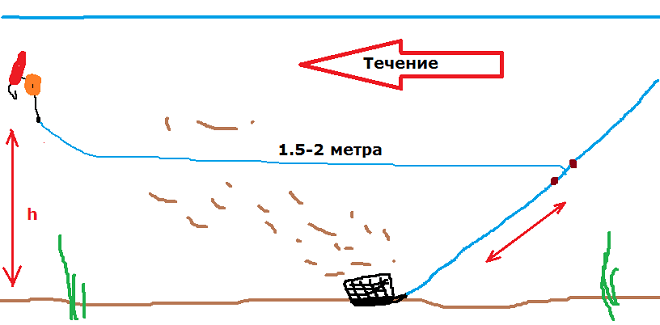
Operation of a paternoster or helicopter
Don't forget to fish actively. If it doesn’t bite for a couple of minutes after casting the feeder, we pull the bait towards ourselves, causing it to oscillate in the flow. Such provocation often provokes a bite. If we are fishing from a bridge, a cape, or a boat, it makes sense to hit the bottom with the feeder, sending the equipment gradually further downstream. After finding the fish and selecting the feeder equipment, you need to catch a certain rhythm of casting, pulling, and then catching sabrefish turns into getting the fish out of the water one by one. You can’t bludgeon and contemplate the quivertip - we are active and experimenting until a fishing system is found. Together with sabrefish, shemai, bleak, roach, and even bream are caught on the feeder in this way.

Garland for catching saberfish
This is a multi-level tackle, where jigs or hooks with bait are located at a certain distance from each other. That is, the baits are located at different depths, which makes searching for fish in the water column much faster and easier. And saberfish in winter are quite fickle in choosing the level of the horizon in which it stays and feeds on a given specific day. This can be both bottom and surface layers of water. Much depends on where the zooplankton, which is also included in the sabrefish’s diet, is located that day.
Share with your friends!
Chekhon on a garland
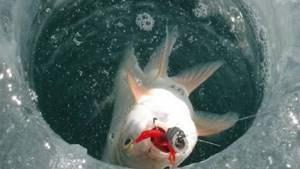
A garland is, in fact, an equipment for a winter fishing rod for targeted fishing for sabrefish and a number of other fish that do not lie at the bottom of an underwater hole. This tackle successfully catches roach, bream and other types of fish that are active during the freeze-up period.
The advantage of this equipment is that you can check the reaction of fish in different horizons. In winter, it allows you to determine the concentration of fish.
Assembling a winter fishing rod equipped with a garland is carried out as follows:
• A sinker is used to fix the tackle on the bottom. Its weight is selected for specific fishing conditions. Current speed and depth are taken into account;
• Above the sinker, leashes with hooks or jigs are tied. The main thing is to learn how to tie the second leash to the main line and using the same principle you can attach the required number of leashes. To form a garland for sabrefish, the distance between the leashes should be 30-50 cm. Experience shows that tying leashes closer to each other is fraught with tangling and overlap;
• The remaining elements of the tackle correspond to the classic winter fishing rod with a nod. Taking into account the weak lips of sabrefish, you should install a moderately rigid rod, in which the whip bends in an arc from the tip to the handle. It is imperative to provide a stand for the fishing rod.
Chekhon on a garland is carried out stationary. It is advisable to use several gears that are located in the field of view. To detect subtle bites of sabrefish, you need to use sensitive nods. The hook is performed after several changes in the position of the nod.
Spinning for sabrefish
To catch saberfish using a spinning rod, you need the appropriate gear. This is either a light or ultralight spinning rod for light baits, or a medium all-rounder, weighted with a bombard. For long casting it is better to use long poles 2.7-3 meters. The light version is suitable for light class rods with test weights of 2-15 grams. Universal test - depending on the bombards used.
Bombarda, or sbirulino, in fact, is not a separate tackle, but an element of equipment, a kind of sliding float-sinker (at the same time). This is a method of delivering light bait at a distance for heavy spinning rods that are not capable of throwing light spinners, wobblers and other baits far on their own. A bombarda helps out when you only have a regular spinning rod for pike or zander, and you don’t want to buy new light-class tackle specifically for sabrefish.
More information about catching sabrefish using bombards
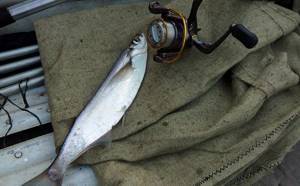
Light spinning equipment
A light spinning rod requires a size 1000-2500 reel. The diameter of the braid is about 1 mm. The thinner the fence, the further you can cast a light bait. When fishing for saberfish, the sensitivity of the gear is important - fishing often takes place at long distances, in the current, where the line is not straight from the spinning rod to the bait.
Although the sabrefish bites confidently, it is still not a pike perch or a pike, and a bite on a spinning rod can be missed if the current inflates the line in an arc. Control and overall sensitivity of the tackle are critical.
A leash is not needed for the saber fish. However, when hunting for large and cautious fish, some anglers use fluorocarbon, which is supposedly invisible in the water. However, this issue is controversial - it is not known for certain what the fish notices better in the water - an opaque thin line with its eyes, or a thick, but invisible fluorine with its lateral line.
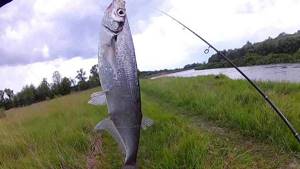
When is the best time to catch
The moment of highest activity of sabrefish on Akhtuba is considered to be the period preceding spawning. The fish feeding begins around the second half of April and can last up to 3 weeks. This is the time to go fishing – saberfish will bite on anything! In an effort to gain strength before spawning, she greedily pounces on the offered bait. And if the angler manages to catch the movement of the school, then in a short time it will be possible to catch a dozen excellent specimens.
Something to remember! During spawning, the bite stops completely and begins again only a few weeks after spawning, when the fish return to their favorite places.
In general, saber can be caught from early spring until the river is covered with ice. In summer, it bites better in the morning, evening and at night. With the arrival of autumn, Czech fish begin to be caught closer to lunch, when the daytime temperature reaches its maximum value. In winter, the saberfish does not show much activity, although some fishermen continue to hunt for it, regardless of the season, and at the same time very successfully.

